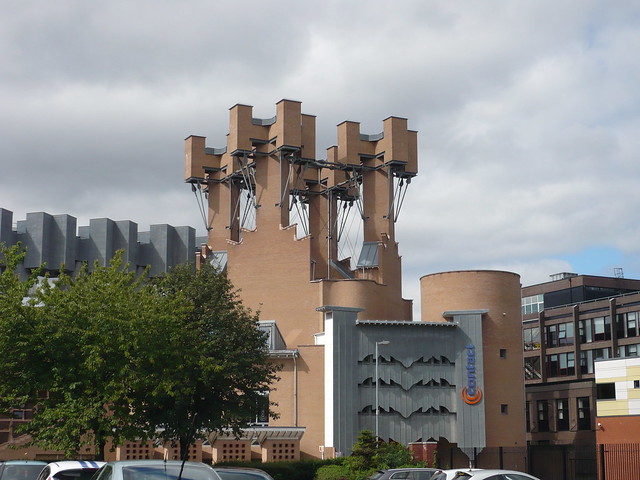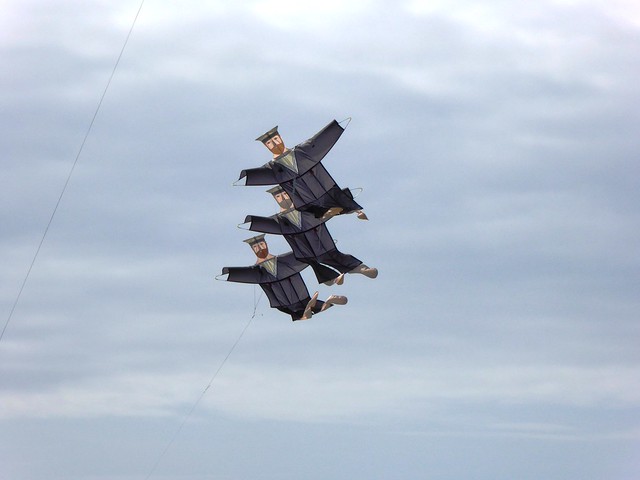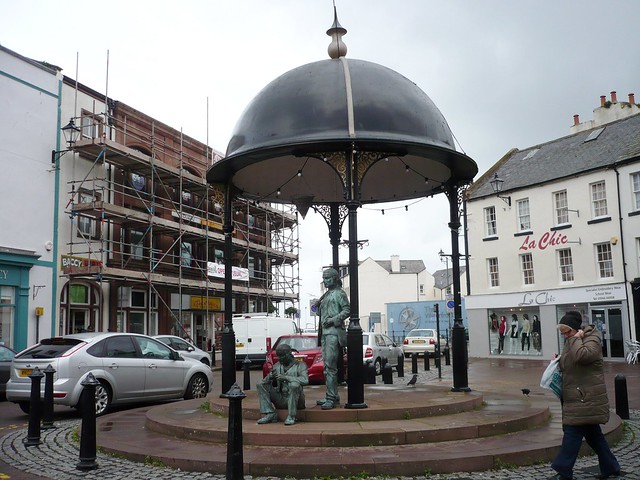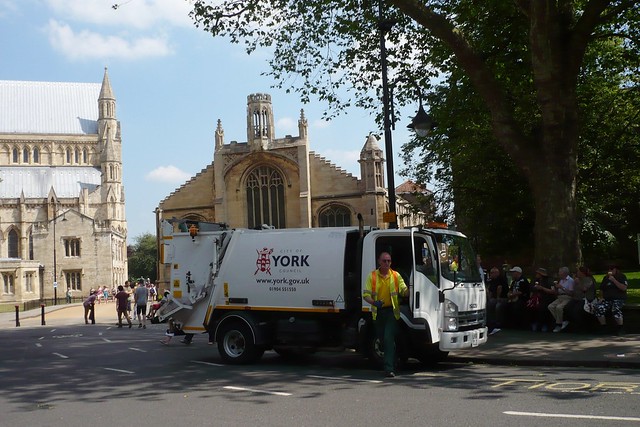Wishing a everyone a Happy Holiday and Merry Christmas
Thursday 24 December 2015
Tuesday 22 December 2015
XXIV Hour Clock
Would I be able to work out the time after an Xmas drink or two with this clock? My brow might furrow. At the time of its installation in 1852 it was a cutting edge Galvano-Magnetic Clock (electricity at the time was called Galvanism). As can be seen by its accumulating number of Xs it is a 24 hour clock. The minute and second hands are conventional but the hour arm goes round the dial only once in 24 hours, or should I say in XXIV hours.
This man stood a long time at the clock which welcomes one into the home of Greenwich Mean Time (GMT) and is called simply the Shepherd 24 Hour Gate Clock. Of course there are also the explanations of The Time Ball (which drops down at 13:00), the Ordnance Survey Bench Mark and the Public Standards of Length. Ah yes the good old days of feet and inches. The inscription of 'Shepherd Patentee' on the clock is significant because there was a dispute when he installed the clocks at Greenwich whether or not he was the inventor (he was). The galvanism or electric signalling transmitted time pulses from Greenwich to slave clocks throughout the country and rather than each area of the country having a different time (nightmare for running a railway system) there was one single time. Eventually, as Shepherd envisioned, the pulses were also sent via submarine cables across the world. The Gate Clock is the visualisation of unified time although there is a rather more workmanlike, but just as interesting, master clock in the observatory.
The Royal Observatory says the Shepherd clock is one of the most photographed objects at the Observatory ( here is an early c1870 view). I proved the Observatory right by taking a picture of the clock location as I entered the gate and a close up of the clock as I left. There was lots to see in-between those two times, not to mention tea and cake on the Gagarin Terrace.
The Royal Observatory says the Shepherd clock is one of the most photographed objects at the Observatory ( here is an early c1870 view). I proved the Observatory right by taking a picture of the clock location as I entered the gate and a close up of the clock as I left. There was lots to see in-between those two times, not to mention tea and cake on the Gagarin Terrace.
An entry to ABC Wednesday, a journey through the alphabet, this week sojourning at X here
Labels:
ABC Wednesday,
Clock,
Greenwich,
Shepherd,
X
Location:
Greenwich, London SE10, UK
Tuesday 15 December 2015
Water
We have had a lot of water recently weeks and weeks of rain as the storms come in wave upon wave from the Atlantic but here on the sunny May days of my photographs there is not a drop is in the air. Silently and unseen an underground water supply makes its way to the taps of the valley. Nature gave us a dryish summer and the boating house of the local park lake closed up because water levels were too low but they were high enough for the resident water fowl.
The Goose family were too quick for me, taking to the water as I approached. I often saw this pair in May always attentive to their lone chick, the other eggs cannot have hatched and probably fallen victim to a predator, I suspect the local herring gulls who are always after an easy meal. Inland the gulls are nowhere to be seen and in a water fountain
this duck is showing off its waterproof feather as it made a slow turn changing direction under the rhododendron trees
Was this little boy about to test the waterproof nature of his clothing (nil) or skin (good)? Water fountains are an irresistable attraction with their frothing water but I think he is undecided and one small step might be enough. It was a rather chilly day, as you can see from the number of people wearing jackets and scarves.
The Goose family were too quick for me, taking to the water as I approached. I often saw this pair in May always attentive to their lone chick, the other eggs cannot have hatched and probably fallen victim to a predator, I suspect the local herring gulls who are always after an easy meal. Inland the gulls are nowhere to be seen and in a water fountain
this duck is showing off its waterproof feather as it made a slow turn changing direction under the rhododendron trees
the sunlight dazzlingoff the droplets.
| Russell Square fountain, London |
An entry to ABC Wednesday, a journey through the alphabet, this week sojourning at W here
Labels:
ABC Wednesday,
Barrow in Furness,
duck,
Fountains,
Holker Hall,
London,
Park,
Water
Tuesday 8 December 2015
Verdant Veg
As I come from an area of heavy clay soil the Suffolk free draining sandy soil fascinates me. Half of the land in this corner of East England grows cereal in its light soil but sugar beet is often grown in rotation as it returns organic matter to the soil. I'm rather fond of crop lines following the roll of a landscape so these verdant leaf lines were irresistible. This is also England's driest and sunniest corner so all sorts of vegetables can be found in the fields
along with a few interlopers. Who does not love the intense colour of a field of sunflowers but the surprise of finding
a bright yellow face shining out of a sea of green brings its own pleasure. With the changes of farming practises the unproductive (in farming terms) margins of fields have become an important habitat for
native flowers, grasses and fauna. Larger fields often mean fewer margins but in
the case of this old footpath running down the middle of a field, the margin is also in the middle. It is a way that must have been walked for hundreds of years through many seasons and rotations of crops to and from Orford's 12th century castle, church and the village.
An entry to ABC Wednesday, a journey through the alphabet, this week sojourning at V here
Tuesday 1 December 2015
Union Jack on Holiday
Union Jacks being flown at the entrance to Port Haverigg Holiday Park to welcome the residents. There was a discussion at the time Scotland was voting whether to become independent of the United Kingdom what our national flag might look like without the St Andrews Cross on it and a number of possible designs produced. As it never happened no need to buy fresh flags, yet.
Lets take a walk down the road
and something unexpected may be seen outside one of the holiday homes which overlook the Hodbarrow Lagoon. A miniature lighthouse, complete with little door, cottage and boathouse made with beach pebbles. Our artist has also included a windmill. Perhaps the miller and the lighthouse keeper go to the
little church across the path on Sundays. It doesn't show up too well on the photograph but the snaking sign says, or should I say hisses, "Pleeesse Water'. A plea to the unheedful gardener?
Lets take a walk down the road
and something unexpected may be seen outside one of the holiday homes which overlook the Hodbarrow Lagoon. A miniature lighthouse, complete with little door, cottage and boathouse made with beach pebbles. Our artist has also included a windmill. Perhaps the miller and the lighthouse keeper go to the
little church across the path on Sundays. It doesn't show up too well on the photograph but the snaking sign says, or should I say hisses, "Pleeesse Water'. A plea to the unheedful gardener?
An entry to ABC Wednesday, a journey through the alphabet, this week sojourning at U here
Labels:
Art,
flag,
Haverigg,
holiday park,
Lighthouse
Tuesday 24 November 2015
Theatre
The Heron Theatre is easy to find for if one turns off the main road into the village of Beetham in Cumbria it is the first building seen by the roadside with its distinctive flying heron sculpture. The building dates from the 18th Century when it was a two room Grammar School but today it is a 80 seat theatre putting on music, film and of course theatre. This rustic space is in contrast to the rather more avant-garde outline of
the Contract Theatre in Manchester. The stacks and chimneys assist with the buildings natural ventilation. This has been home to various theatre companies but in 1999 it became a national arts organisation with a 300 seat theatre and a 70 seat studio in the turret. Part of the University of Manchester it is run by young people (13+) together with the staff who put on a variety of performing arts programmes thorughout the year. No matter the how big or small the venue neither would be anything without the actors
and here is the statue of Lawrence Olivier (1907-1989) as Hamlet outside the National Theatre in London which was erected on the centenary of his birth in 2007. As in life, in death he had drawn a small crowd around him. I could not resist snapping them as they investigated and discussed what the statue was. The lone Japanese tourist in the distance is concentrating on the National Theatre building itself where Olivier was its first artistic director in 1963. The main stage seating 1100 and modelled on the ancient Greek theatre at Epidauris is named after him He was so prolific on stage and screen that he gets two wikipeadia page entries but here is the one for his his credits. I don't think he ever stopped working (until the grim reaper intervened) either as an actor or director.
the Contract Theatre in Manchester. The stacks and chimneys assist with the buildings natural ventilation. This has been home to various theatre companies but in 1999 it became a national arts organisation with a 300 seat theatre and a 70 seat studio in the turret. Part of the University of Manchester it is run by young people (13+) together with the staff who put on a variety of performing arts programmes thorughout the year. No matter the how big or small the venue neither would be anything without the actors
and here is the statue of Lawrence Olivier (1907-1989) as Hamlet outside the National Theatre in London which was erected on the centenary of his birth in 2007. As in life, in death he had drawn a small crowd around him. I could not resist snapping them as they investigated and discussed what the statue was. The lone Japanese tourist in the distance is concentrating on the National Theatre building itself where Olivier was its first artistic director in 1963. The main stage seating 1100 and modelled on the ancient Greek theatre at Epidauris is named after him He was so prolific on stage and screen that he gets two wikipeadia page entries but here is the one for his his credits. I don't think he ever stopped working (until the grim reaper intervened) either as an actor or director.
An entry to ABC Wednesday, a journey through the alphabet, this week sojourning at T here
Tuesday 17 November 2015
Sailors
Ahoy there its time for dancing sailors high in the sky. The crew are flying past at the Haverigg Kite Festival and required quite a bit a skill both to get them in formation for their hornpipe but also to get them aloft in very little wind.
There was still plenty of kite flying and routines to enjoy but some of the larger pieces such as this seahorse remained resolutely earth bound on a still August day.
One could sail up the coast from Port Haverigg and come across some sailors forever on land near Whitehaven harbour.
Created by John McKenna as part of the port's 'Quest' project these two are simply called "Sailors Waiting for Crew Work". Happily to add to the 'S' count for this ABC Wednesday post there is also some scaffolding ready for the roofers in the background. Apart from its Georgian harbour one of Whitehaven's other claims to fame is of the attempt by the USS Ranger commander, John Paul Jones, to set fire to the hundreds of ships anchored in the port in 1778. Alas for him the row in small boats against the tide for 3 hours, the wind, a mutinous crew and the lure of the local pub for the sailors this was not a success. The full story can be found here The Quest project produced other sculptures around the town by John McKenna including one of John Paul Jones in action and spiking the guns at Half-moon Battery here.
There was still plenty of kite flying and routines to enjoy but some of the larger pieces such as this seahorse remained resolutely earth bound on a still August day.
One could sail up the coast from Port Haverigg and come across some sailors forever on land near Whitehaven harbour.
Created by John McKenna as part of the port's 'Quest' project these two are simply called "Sailors Waiting for Crew Work". Happily to add to the 'S' count for this ABC Wednesday post there is also some scaffolding ready for the roofers in the background. Apart from its Georgian harbour one of Whitehaven's other claims to fame is of the attempt by the USS Ranger commander, John Paul Jones, to set fire to the hundreds of ships anchored in the port in 1778. Alas for him the row in small boats against the tide for 3 hours, the wind, a mutinous crew and the lure of the local pub for the sailors this was not a success. The full story can be found here The Quest project produced other sculptures around the town by John McKenna including one of John Paul Jones in action and spiking the guns at Half-moon Battery here.
An entry to ABC Wednesday, a journey through the alphabet, this week sojourning at S here
Tuesday 10 November 2015
Reduce Refuse
A small group takes refuge from the summer sun under a tree and lick their cooling ice cream cornets, the ultimate in litter free treats. The council worker alights from a refuse truck on his journey past York Minster (just visible on the left) and the Church of St Michael le Belfrey to check the litter bins in an area where happily not a scrap of rubbish can be seen.
To continue the theme nearer to my home here is a mural with a message as imagined by one of the local schools, Greengate Infants and Junior School - 'Reduce, Reuse, Recycle', a good motto to promote. The school formed a partnership with the construction company building a care home for older people on the same street and there are a number of murals around the building on different subjects painted on the site fencing. Who knows the other ones might come in handy for another letter of ABC Wednesday!
Lastly we take a trip to a recycling area taken a few days after last Christmas when the bottle banks were already full and the excess was starting to line up in front. A journey to the bottle bank has almost become part of the Christmas tradition and by the time the recycling guys go back to work there will certainly be a whole lot more as the population takes the message "eat, drink and be merry" to heart.
To continue the theme nearer to my home here is a mural with a message as imagined by one of the local schools, Greengate Infants and Junior School - 'Reduce, Reuse, Recycle', a good motto to promote. The school formed a partnership with the construction company building a care home for older people on the same street and there are a number of murals around the building on different subjects painted on the site fencing. Who knows the other ones might come in handy for another letter of ABC Wednesday!
Lastly we take a trip to a recycling area taken a few days after last Christmas when the bottle banks were already full and the excess was starting to line up in front. A journey to the bottle bank has almost become part of the Christmas tradition and by the time the recycling guys go back to work there will certainly be a whole lot more as the population takes the message "eat, drink and be merry" to heart.
An entry to ABC Wednesday, a journey through the alphabet, this week sojourning at R here
Labels:
ABC Wednesday,
Barrow in Furness,
bottles,
Murals,
refuse,
Van,
York
Tuesday 3 November 2015
The Queens
A liner floats in the sky above a building in Birkenhead which stands on the junction of two roads
and is named after the Queens who are the Cunard liners. These are not their modern cruise ships whose design looks like a human container ship but the iconic lines of the Queens from the 1930s who vied with other vessels to make the fastest crossing of the Atlantic from Southampton to New York.The building is a pub and hotel owned by Admiral Taverns (continuing the nautical theme). I'm assuming the name is related to the fact that Cunard headquarters were originally in Liverpool and their beautiful old building forms one of the 'Three Graces' on the city's waterfront. The Queens however is tucked away on the other side of the Mersey by Birkenhead Park. In the early afternoon on an April day the area seemed quite deserted, maybe the chill and grey skies had something to do with it.
To make up for the lack of activity on the photograph here is an interior shot of the Queen Mary (the first of the Queens), being fitted out on Clydeside in Art Deco style in about 1935. (The photographer is Yevonde Middleton (Madam Yevonde) a pioneer of colour photographer)
The joiners are busy behind the bar. The two 'customers' may have a long wait for any liquid refreshment.
An entry to ABC Wednesday, a journey through the alphabet, this week sojourning at Q here
Labels:
ABC Wednesday,
Birkenhead,
Pub Sign,
Pubs,
Queens,
Ships
Location:
Birkenhead, Merseyside, UK
Tuesday 27 October 2015
Pan Pipes
On a summers day in York this duo of South American street musicians were entertaining the shoppers with their feathers, flute and pan pipes. I have seen them in various town centres in the north of England on both sides of the Pennines. I imagine in the winter they would have to wear something a little warmer, or perhaps they fly south.
An entry to ABC Wednesday, a journey through the alphabet, this week sojourning at P here
Tuesday 13 October 2015
Needle Navigation
Known locally as simply 'The Needle' this is the only survivor of 13 navigation beacons build in the 19th Century (c1875) to lead ships in the port of Barrow in Furness. The brickwork is red and yellow but the June flowers are outdoing the structure for yellowness. Its official title is Leading Light Number 4 and the 66 feet (20m) needle rises on the foreshore at Rampside. Originally one of the other towers would have been nearby on the Island of Foulney, a low lying shingle spit home to nesting birds which can be walked to at low tide
on an old shingle and rock causeway
and is somewhere in the middle distance to the left of the Needle in this photograph. Piel Island and its castle can be glimpsed on the horizon to the right. What a pity there is no time machine to journey back in time and see the glow of 13 beacons shining out in a dark 19th Century sky warning and guiding ships as they thread their way through channels, past sandbanks, islands and shingle spits safely into port.
on an old shingle and rock causeway
and is somewhere in the middle distance to the left of the Needle in this photograph. Piel Island and its castle can be glimpsed on the horizon to the right. What a pity there is no time machine to journey back in time and see the glow of 13 beacons shining out in a dark 19th Century sky warning and guiding ships as they thread their way through channels, past sandbanks, islands and shingle spits safely into port.
Labels:
ABC Wednesday,
Barrow in Furness,
Beacon,
Navigation,
Needle,
Rampside
Tuesday 6 October 2015
Monkey Puzzle
Here is a conifer on the very start of its journey when instead of looking down we will be looking up to eighty, a hundred or more feet. This is the Chilean Pine which used to be abundant in that country but a million have been burnt in forest fires as the climate becomes hotter and drier and the fires become more frequent. The English speaking world knows the tree more familiarly as the Monkey Puzzle and you can judge its hight here below by the house in the background..
The seeds of the tree are edible (although do not appear until the trees are 30-40 years old). When the botanist Archibald Menzies was served them as a desert at a dinner given by the Governor of Chile in 1795 he pocketed a few and grew them on the ship back to Europe, of the resulting 5 healthy plants two were planted at Kew Gardens. Fast forward to 1850 and Charles Austin (a barrister who made his fortune during the Victorian Railway Mania era) was being shown around a garden in Bodmin, Cornwall and made the comment "It would puzzle a monkey to climb that" and the tree became popularly known as the Monkey Puzzler and then the current name of Monkey Puzzle. The French call them désespoir des singes (monkey's despair)
Like the set of four trees above most were planted in the landscape gardens of large houses in the 19th Century and these trees from the Jurrasic era (sometimes called a living fossil) were quite a status symbol. In the 1900s and especially the 1920s they became a very popular plant for the suburban garden where they just grew and grew. I seem to remember there used to be a lot more around but perhaps their large size and sharp pointed leaves may have overwhelmed the owners, or maybe I just found them fascinating as a child so noticed them more. Today a lot of these long lived trees have tree preservation orders on them so they cannot be cut down and remain to entrance us. Perhaps I am wrong about the numbers for Sarah Horton in a labour of love is mapping Monkey Puzzles here and blogs about it here joined by her Monkey Puzzle agents to potentially photograph and map the Monkey Puzzle world, although as she is based in Liverpool there may be a British Isles bias.
The seeds of the tree are edible (although do not appear until the trees are 30-40 years old). When the botanist Archibald Menzies was served them as a desert at a dinner given by the Governor of Chile in 1795 he pocketed a few and grew them on the ship back to Europe, of the resulting 5 healthy plants two were planted at Kew Gardens. Fast forward to 1850 and Charles Austin (a barrister who made his fortune during the Victorian Railway Mania era) was being shown around a garden in Bodmin, Cornwall and made the comment "It would puzzle a monkey to climb that" and the tree became popularly known as the Monkey Puzzler and then the current name of Monkey Puzzle. The French call them désespoir des singes (monkey's despair)
Like the set of four trees above most were planted in the landscape gardens of large houses in the 19th Century and these trees from the Jurrasic era (sometimes called a living fossil) were quite a status symbol. In the 1900s and especially the 1920s they became a very popular plant for the suburban garden where they just grew and grew. I seem to remember there used to be a lot more around but perhaps their large size and sharp pointed leaves may have overwhelmed the owners, or maybe I just found them fascinating as a child so noticed them more. Today a lot of these long lived trees have tree preservation orders on them so they cannot be cut down and remain to entrance us. Perhaps I am wrong about the numbers for Sarah Horton in a labour of love is mapping Monkey Puzzles here and blogs about it here joined by her Monkey Puzzle agents to potentially photograph and map the Monkey Puzzle world, although as she is based in Liverpool there may be a British Isles bias.
An entry to ABC Wednesday, a journey through the alphabet, this week sojourning at M here
Labels:
ABC Wednesday,
Cumbria,
Holker Hall,
Monkey Puzzle,
Tree
Saturday 3 October 2015
Small Tortoiseshell
Small tortoiseshell enjoying the unusually warm October weather amongst the flowers.
which are as brightly coloured as it is.
Soon it will be time for winter sleep and a dreaming of cloud flowers.
Tuesday 29 September 2015
Little Lines
Little trains on little lines and running today, well actually Sunday afternoons from March to October in Barrow Park.
Here is one of the diesels running past the old Furness Railway Signal Box (Devonshire Road) which provides water for the steam engines
and copious cups of tea for the member of the Furness Model Railway volunteers. I'm not sure how long this little railway has been running in the park but the society itself was formed in 1956 and in the 1960s the Devonshire Road Signal Box was still located on the old railway line on the Low Road.
Returning to the present here is one of the little trains completing its circuit.
Of course every railway has an engineering shed and the Furness Model Railway is no exception
On a beautifully warm September afternoon the best place to tinker with the rolling stock
The signals up, the engine's steaming and a wave from the 'station'
The little lines run in a quarter mile circuit on an elevated 3.5 and 5" gauge track and various model locomotives pull the 'carriages'.Here is one of the diesels running past the old Furness Railway Signal Box (Devonshire Road) which provides water for the steam engines
and copious cups of tea for the member of the Furness Model Railway volunteers. I'm not sure how long this little railway has been running in the park but the society itself was formed in 1956 and in the 1960s the Devonshire Road Signal Box was still located on the old railway line on the Low Road.
| Photo from: http://www.southlakes-uk.co.uk/userrequested.html |
Of course every railway has an engineering shed and the Furness Model Railway is no exception
On a beautifully warm September afternoon the best place to tinker with the rolling stock
is under clear sunny skies
Walking through Barrow Park today all was quiet, the signal was at stop, the signal box locked up (I'm cheating here as I took this photo back in March), the lines were empty but nearby there was still a set hobbyists in place but in this case, model ships rather than trains, and putting their
sailing ships through their paces round the buoys of the park lake for Tuesday is their day.
An entry to ABC Wednesday, a journey through the alphabet, this week sojourning at L here
Labels:
ABC Wednesday,
Barrow in Furness,
Cumbria,
Furness Model Railway,
Park
Location:
Barrow-in-Furness, Cumbria, UK
Subscribe to:
Posts (Atom)












